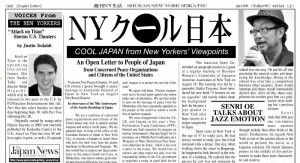“100 Yen Love” – Film Review from the 19th Japanese Film Festival (Australia and New Zealand)
Eden Law (Fukushima-ken ALT 2010-2011) reviews “100 Yen Love”, a character-driven drama about the beautiful losers of life, you and me, baby.
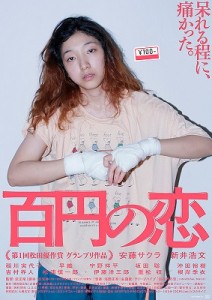
Mama said knock you out
A film with indie sensibilities, 100 Yen Love is a slow-burn treat, a small-town drama that may not seem to have much to offer like its protagonist, but it’s the little things about this film that prove to be the most satisfying. Already saddled with a string of awards, director Take Masaharu’s film is Japan’s official entry into the foreign-language category in this year’s Oscars.
Ichiko (Ando Sakura) is a slacker – directionless at the ripe old age of 32 with little prospects and mooching off her accommodating parents in an unremarkable and plain town that could be set anywhere in Japan. She barely expends energy on anything, almost incomprehensible in her speech, and neglectful of her appearance, wearing slept-in clothes, her face half-covered by unruly hair with long-grown-out roots, shuffling in a stooped posture to the local convenience store for late night junk food and manga. However, she is forced to leave home after an altercation with her antagonistic sister, and to support herself by working at a dead-end job at the same convenience store she used to frequent. Along the way, she enters into an awkward, maybe-romance with a taciturn and brusque man from the local boxing gym that her workmates call “Banana Man” (Arai Hirofumi), because of his odd habit of buying massive amounts of bananas. For the first time, Ichiko has to rely on herself in dealing with all the trials of being an adult, and they can be very, very brutal indeed.
To describe 100 Yen Love simply, you could call it an inspirational, transformative story through the genre of sports – boxing, in this case, as Ichiko, finding focus for the first time in her life, transforms from a loser to a lean, powerful athlete. And yes, there is the usual training montage of a zero-to-hero, helped along by a rock-out soundtrack that was shamelessly enjoyable and inspirational, though the film meanders for quite a while before reaching this part. But Ichiko’s journey doesn’t feel like a cliche – Ando, in her role, really did an amazing job – bringing a muscularity to her role (apparently Ando did actually trained at a local boxing gym in her teens), and truly inhabiting Ichiko, growing bolder and more confident in her mannerisms and stature. At first an unwilling participant in the course of her own life, she finally takes control, not for any lofty message or plot-driven ideals, but because she needed to.
As mentioned, there is satisfaction in the small things in this film – the background is populated by a cast of quirky characters who provide humour and humanity to the general greyness of the film, although some characters are harder to stomach than others. Like the climatic boxing match that Ichiko finally enters into, the film is not beautiful to watch, but will reward the patient viewer who sticks with it to see what happens next. Sometimes the small things can be just as epic and satisfying.
“Kakekomi” – Film Review from the 19th Japanese Film Festival (Australia and New Zealand)
Eden Law (Fukushima-ken ALT 2010-2011) reviews “Kakekomi”, a historical comedy drama set in 19th century Japan, about kakekomi, women who seek divorce from abusive husbands by fleeing to a temple sanctuary. And yes, I did say comedy, along with the drama.
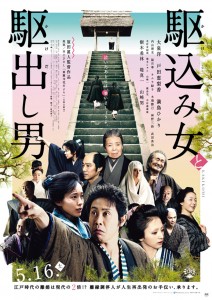
Sisters are doing it for themselves
A light, historical comedy-drama set in mid-19th century Japan, kakekomi refers to the sole method by which women in feudal Japan could legally divorce their husbands, by seeking refuge in a temple for a period of time, after which the marriage would be declared null and void by law. In this time period, Edo (now modern-day Tokyo) groans under the severe austerity and moral reforms imposed by a puritanical government that seeks to outlaw all corrupting pleasures and foreign influences, such as Christianity, western medicine, entertainment (both traditional and foreign) and ironically, sushi. Even the use of colour in print is considered subversive, as a character complains about the unexciting and plain novels available for sale.
Two women, meeting by chance on a dark night on a lonely road, journey to Tokei-ji in order to become kakekomi – Jogo (Toda Erika), who seeks to escape from an abusive marriage, and O-Gin (Mitsushima Hikari), a beautiful and refined concubine whose reasons for leaving are not clear. They are assessed by the administrators of a local inn for their suitability, aided by the wise Genbei (Kiki Kirin). Also seeking refuge at the inn, is Genbei’s nephew Nakamura Shinjiro (Oizumi Yo), an idealistic and eccentric student of medicine with ambitions to be a writer. Over two years, the temple, its inhabitants and the local inn have to contend with various issues and problems, including dissatisfied husbands seeking the return of their wives.
An adaptation of the novel Tokeiji Hanadayori by Hisashi Inoue, Kakekomi moves at a brisk pace, juggling several story lines with a large cast of characters. Considering a rather confusing first part, where subplot introductions and dialogue whizz past at dizzying speed (testing one’s ability to speed-read the subtitles), the film surprisingly manages to tie all the strands together fairly well, although there is a bit of deus ex used in the resolution of some of these. Incredibly, director Harada Masato made a four-hour version before merciless editing it down to about 2.5 hours, which helps explain the sometimes disjointed and out-of-place feel of certain scenes, with some secondary characters being little more than a slightly caricaturised plot device. This doesn’t mean however that Kakekomi is unenjoyable – thanks in large part to the great cast. Oizumi’s rubbery-faced Shinjiro, is a highly endearing goofball, who deftly manages to balance comedy and seriousness. Toda, as Jogo, is fantastic to watch as her character grows in confidence and strength throughout the film. Special mention goes to Hizuki Hana who plays the Tokeiji’s Abbess, a living embodiment of the phrase “an iron fist in a velvet glove” – managing to be hilarious and terrifying at the same time.
Apart from bursting at the edges with plots, the film is also crammed with both the visual and aural delights. The cinematography is gorgeous, filmed on location in an actual centuries-old temple complex, and the passing of the seasons and time is impossibly picturesque – and that opening shot of raindrops falling onto a carpet of moss, creating tiny pits over time, is just poetry. Those with a love of period costume will drool over the historically accurate costumes and sets, faithfully reproduced. The characters also sing a lot of songs – the film is not a musical by any means, but it gives a rich depiction of culture that the conservative government is trying to suppress as being decadent. Kakekomi might not really have an agenda other than a desire to entertain, but there is a strong message about censorship and resistance to change, and most of all, about the benefits of empowerment, especially of its female characters, who are just as strong and capable as – sometimes even more than – the men. Kakekomi is definitely engaging and well worth watching, and I would love to check out the full-length director’s cut if it ever comes out on DVD (at least then I can hit the pause button to read the subtitles in full).
The 18th Japanese Film Festival in Australia
Australia’s Japanese Film Festival is the world’s biggest Japanese film festival, with the 2014 program attended by an estimated 31,800 viewers, nation-wide. In November, the film festival will begin in Sydney with over 50 films in its repertoire, with some big tickets items making their world-premier showing outside of Japan. An absolute treat for film lovers, and one you should make your way down under for. Eden Law (Fukushima-ken, 2010-11) gives you the what’s up and the low down on 2015’s 19th Japanese Film Festival.
18th Japanese Film Festival promo video, courtesy of Japan Foundation, Sydney
With so many films available, it can be difficult to decide on which you should spend your time (and your five-movie pass) on. JFF’s organisers have always chosen films to create a carefully balanced program, between thought-provoking drama, to more popular servings of comedy and gore-soaked action and horror – and of course, several anime entries, without which a Japanese film festival cannot be considered complete. Live-action adaptation of popular manga and anime series make a strong appearance – Assassination Classroom (about a class of delinquents tasked with killing their teacher, an almost-invincible tentacled monster), No Longer Heroine (about high school romances) and the rather meta Bakuman, about the trials and tribulations of making it as a manga artist.
In the cult category, Sion Sono – enfant terrible, wildcard, Japan’s Tarantino, what have you – returns with Tag, a surreal (and violent) struggle for survival that takes place through several lives and existence. Yet he surprises with Love & Peace – an equally surreal, but far more light-hearted and G-rated story about realising cherished dreams and singing animals. Not to be outdone, Sono’s sempai Takashi Miike has his high school characters endure an outlandish survival horror scenario as gods play with them for idle amusement in As the Gods Will.
A new Ghost in the Shell is the most exciting entry in the anime category, and should need no introduction. Of special mention is Miss Hokusai, the historical biography of the youngest daughter of the famous printmaker Hokusai, Katsushika Oi. Though little known today, she is said to be not only a talented artist like her father, but also a vivacious woman, full of humour and spirit.
And finally, for those seeking more weighty subject matter, the festival closes out with 100 Yen Love, Japan’s official entry for Best Foreign Language Film at this year’s 88th Academy Awards. Already festooned with awards for best film, director and best actress, this independent film of the unexpected blossoming of an aimless “loser” should be one to watch – yes it’s a sports film, but don’t let that put you off. Of particular excitement this year is the showing of Akira Kurosawa’s classic Ran, restored in 4K format – plenty of hipster cred there.
Check out the website (http://japanesefilmfestival.net/) for more on 2015 JFF, and stay tuned for reviews!
Justin’s Japan: ‘Ghost in the Shell’ returns, ‘Allegiance,’ Jake Shimabukuro
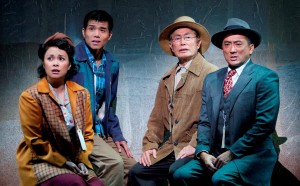
“Allegiance,” a new Broadway musical starring Tony Award winner Lea Salonga (left) and George Takei (second from right) premieres at the Longacre Theatre Nov. 8. (Henry DiRocco)
By JQ magazine editor Justin Tedaldi (CIR Kobe-shi, 2001-02) for Examiner.com. Visit his Japanese culture page here for related stories.
From Broadway to anime to J-pop, November is just as colorful as the leaves gliding through the air. Add to that a cutting-edge Noh-inspired stage spectacle, a classical collegium performance and the return of the undisputed ukulele master, and you’ve got an irresistibly epic rundown.
This month’s highlights include:
Oct. 31-Nov. 1, 12:00 p.m.
We Are Perfume: World Tour 3rd Document
Anthology Film Archives, 32 Second Avenue
$18
This new documentary follows the veteran all-girl pop trio on a two-month international live tour (which made a stop at New York’s Hammerstein Ballroom last November). While traveling around the globe to cities across Asia, Europe, and the United States, audiences will see Perfume’s powerful live performances and catch never before seen behind-the-scenes footage. Witness the group’s single-minded approach to their performances – the joy, anguish, and struggles, not only in the music, but also in fashion and pop culture.
Nov. 2 & 8
Village East Cinema, 181-189 Second Avenue
$14
From the creative team behind Anohana, The Anthem of the Heart tells the story of Jun, once a happy young lady with a tenacious personality. Jun has torn her family apart by saying something hurtful, and her ability to speak has been sealed away by the Egg Fairy in order to stop her from hurting others. Now, Jun lives in the shadows and avoids the limelight. But when she is nominated to become the executive member of the Community Outreach Council and appointed as the main lead in the council’s musical, Jun will have to find her voice and the wisdom to temper her words. Presented in Japanese with English subtitles.
Nov. 3, 5-8
BAM Harvey Theater, 651 Fulton Street (Brooklyn)
$25-$70
An angel’s garment, possessed of mysterious powers, falls to a remote island on Earth, where it is found by a poor fisherman. To get it back, the angel offers up her greatest celestial gift: a dance of incomparable beauty. Dance icons and former New York City Ballet principals Wendy Whelan and Jock Soto, contralto Katalin Károlyi and tenor Peter Tantsits, and puppets by Chris Green come together in this inspired reimagining of a Japanese Noh theater classic. With choreography by David Neumann, costumes by Belgian fashion icon Dries Van Noten, and an original score by Nathan Davis—performed live by the International Contemporary Ensemble and Brooklyn Youth Chorus—Hagoromo merges genres to send a stranded spirit back to heaven.
For the complete story, click here.
Justin’s Japan: ‘Naruto’ takes Comic Con, ‘Legend of Zelda,’ L’Arc~en~Ciel
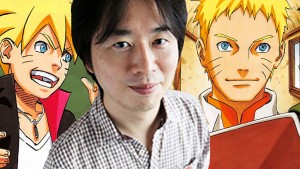
Naruto creator Masashi Kishimoto makes his first-ever appearances outside of Japan in New York Oct. 7-10. (Courtesy of ForeverWorld)
By JQ magazine editor Justin Tedaldi (CIR Kobe-shi, 2001-02) for Examiner.com. Visit his Japanese culture page here for related stories.
The Japan-centric events of the month ahead promise to be as rich and full as autumn itself—brisk and colorful, with a dash of unpredictability.
This month’s highlights include:
Oct. 8-11
Jacob K. Javits Convention Center, 655 West 34th Street
Limited tickets available
The East Coast’s biggest gathering for fans of comics, film, anime and manga, New York Comic Con returns with its biggest roster of Hollywood talent to date, including the first-ever appearance outside of Japan of Naruto creator Masashi Kishimoto, on hand for an exclusive Q&A panel (Oct. 8, 5:30 p.m.) as well as the North American theatrical debut (Oct. 10, 11:30 a.m. at Hammerstein Ballroom) of Boruto: Naruto the Movie! In addition, Kishimoto will also make live appearances at Apple Store SoHo (Oct. 7, 7:00 p.m.), Kinokuniya Book Store (Oct. 9, 8:30 p.m.) and Barnes and Noble Tribeca (Oct. 10, 3:30 p.m.). Don’t miss this chance to meet one of Japan’s most popular contemporary manga artists!
Oct. 9-Jan. 10
For a New World to Come: Experiments in Japanese Art and Photography, 1968-1979 Japan Society Gallery, 333 East 47th Street
$12 students and seniors, $10, Japan Society members. Free on Friday nights, 6:00-9:00 p.m.
In the wake of the social and political upheaval of the late 1960s, Japanese artists and photographers began crafting a new visual language for an age of uncertainty. Their embrace of camera-based experiments would alter the cultural landscape and lay the foundations for contemporary art in Japan. For a New World to Come is the first comprehensive exhibition to spotlight this radical break with the past. With some 200 works by such luminaries as Ishiuchi Miyako, Daidō Moriyama, Jirō Takamatsu, and Shōmei Tōmatsu, the exhibition charts the stunning diversity of photographic practices during this pivotal era, from conceptual series situated squarely within global artistic currents, to visually arresting meditations on time, place, and self.
Oct. 10, 12, 13, 17, 19, 21
Village East Cinema, 181-189 2nd Ave.
$15
See the next generation of Naruto on the big screen! With Naruto as the Seventh Hokage, Hidden Leaf Village is planning to host the Chunin Exams to train new shinobi. Among the entrants are Sasuke’s daughter, Sarada, who adores Naruto, Mitsuki, an exceptionally talented yet mysterious shinobi, and Boruto, Naruto’s son who shows great potential, but despises his father. Sasuke, who’s been on a mission in another dimension, appears before Naruto to warn of a strange impending danger he has sensed. An inconceivable foe lies in wait as Sasuke, the Five Kage, and Boruto charge into another dimension!Presented in Japanese with English subtitles.
For the complete story, click here.
Nippon in New York: ‘Attack on Titan,’ Taylor Anderson Memorial, Luckyrice Fest

The live-action film debut of Attack on Titan premieres at Village East Cinema Sept. 30. (Courtesy of FUNimation)
By JQ magazine editor Justin Tedaldi (CIR Kobe-shi, 2001-02) for Examiner.com. Visit his Japanese culture page here for related stories.
As the summer winds fade into fall colors, the weeks ahead are shaping up with these exciting events, ready to be enjoyed after Labor Day.
This month’s highlights include:
Tuesday, Sept. 8, 6:30 p.m.
Japanese Design Today: Unique, Evolving, Borderless
UL105, University Center, The New School, 63 Fifth Ave.
Free (click here to register)
Japanese design has been proven capable of transcending language barriers and fostering communication and understanding between cultures, enthusiastically embracing elements of other cultures while developing and retaining its own unique sense of design aesthetic, which today is recognized and appreciated throughout the world. But as Japanese society has transformed socially, geopolitically, and economically, so has Japanese design transformed to accommodate these changes which has given way to a new era. Hiroshi Kashiwagi, professor at Musashino Art University, and architect/ furniture designer Yoshifumi Nakamura will each discuss the evolution, distinguishing characteristics, and current state of Japanese design today. A Q&A session will follow the presentations.
Friday, Sept. 11, 7:00 p.m.
The Concert Hall — New York Society for Ethical Culture, 2 West 64th Street
$20
Celebrating its eighth annual concert, this year Circle Wind will give tribute to Taylor Anderson, an American victim of the the Great East Japan Earthquake/Tsunami on March 11, 2011. Anderson was dispatched to Ishinomaki under The Japan Exchange and Teaching (JET) Program in 2008 and was teaching English to schoolchildren there. The newly formed “Never Give Up Taylor’s Choir” from the Ishinomaki/Higashi-Matsushima area will perform an original piece symbolizing their appreciation for the American people’s support to recover from the devastation in 2011. Maestro Gregory Singer and his Manhattan Symphonie Orchestra also returns to perform some tribute songs for Taylor together with koto soloist Masayo Ishigure and other prominent artists. Hosted by New York’s choral harmony group Tomo.
Saturday, Sept. 12
Double feature: Live Your Dream and Dream Beyond 400 Years
Nippon Club of New York, Rose Room, 145 West 57th Street
$10 per film (at 5:00 p.m. and 6:45 p.m.)
Live Your Dream is a story about the courage and sacrifice of Taylor Anderson and for all the young people who travel the world trying to make a difference. Taylor was an extraordinary American who on the JET Program dedicated herself to teaching Japanese children, living her dream right up to the disaster of March 11, 2011. In the New York premiere of Dream Beyond 400 Years, local choir Tomo took a journey to Coria Del Rio in Spain, representing a journey going beyond 400 years. In this town, they met “Japón-san,” the descendants of Japanese travelers to Spain 400 years ago. The members of Tomo and Japón-san form a lifelong friendship in this touching real-life story. An after-screening reception featuring Circle Wind Concert participants and members of Taylor Anderson’s family will be held at 7:30 p.m. ($40).
For the complete story, click here.
Justin’s Japan: ‘Attack on Titan’ Storms U.S. Theaters
By JQ magazine editor Justin Tedaldi (CIR Kobe-shi, 2001-02) for Shukan NY Seikatsu. Visit his Examiner.com Japanese culture page here for related stories.
Attack on Titan is the upcoming live-action feature film from Studio Toho and director Shinji Higuchi, which will be released in two parts in the U.S. by FUNimation Entertainment this fall. Part One hits select theaters for three days beginning Sept. 30, with Part Two following Oct. 20.
Originally created by manga artist Hajime Isayama in 2009 and currently published by Kodansha Comics in the U.S., Attack on Titan has over 50 million copies in print, as well a 25-episode anime series, also produced by FUNimation for American audiences. The series is so popular that a special Titan-themed attraction opened at Universal Studios Japan earlier this year.
The film’s official U.S. release comes swiftly after Part One’s world premiere at the Egyptian Theater in Los Angeles on July 14 and its Japanese release on Aug. 1. Written by Yusuke Watanabe, the films star Haruma Miura and Kiko Mizuhara as two young soldiers living in a deadly post-apocalyptic land where humans fight man-eating Titans for their very survival.
“FUNimation is honored to host the world premiere of Attack on Titan here in the United States with Toho,” said FUNimation president and CEO Gen Fukunaga in a press release. “Attack on Titan is truly a worldwide phenomenon and we are excited to bring the live-action movie to theaters.”
For more information, visit http://attackontitanthemovie.com.
Justin’s Japan: Nippon in New York—‘Dragon Ball Z,’ Liberty City Anime Con, Waku Waku NYC

Dragon Ball Z: Resurrection ‘F’ premieres the week of Aug. 3 at three Manhattan-area locations. (FUNimation)
By JQ magazine editor Justin Tedaldi (CIR Kobe-shi, 2001-02) for Examiner.com. Visit his Japanese culture page here for related stories.
In the dog days of summer, it’s best to escape the heat in a place that’s cozy and cool. For those into Japanese cultural events, this month offers a diverse selection of film premieres and live music—all in the comfort of indoor air conditioning.
This month’s highlights include:
Aug. 4, 5, 7, 8 & 11
Dragon Ball Z: Resurrection ‘F’
AMC Empire 25, 234 West 42nd Street
Chelsea Cinemas, 260 West 23rd Street
Village East Cinema 7, 181-189 2nd Avenue
$15
Hot on the heels of last year’s summer blockbuster, Battle of Gods, Resurrection ‘F’ is the second film personally supervised byDBZ creator himself, Akira Toriyama. The new movie showcases the return of Frieza, the galaxy’s most evil overlord. After years in spiritual purgatory, Frieza has been resurrected and plans to take his revenge on the Z-Fighters of Earth. Facing off against Frieza’s powerful new form and his army of 1,000 soldiers, Goku and Vegeta must reach new levels of strength in order to protect Earth from their vengeful nemesis. English dub version.
Friday, Aug. 28, 6:00 p.m.
Always: Sunset on Third Street 3
Japan Information Center Gallery, Consulate General of Japan in New York
299 Park Avenue, 18th floor
Free (email RSVP to kanako_shirasaki[at]jfny.org; photo ID required upon entry)
A special screening of the third film in the wildly popular series! In 1964, novelist Ryunosuke Chagawa (Hidetaka Yoshioka) has married Hiromi (Koyuki), and the two now share a happy life with Junnosuke (Kenta Suga), the young boy he had taken in during the first film, who is now in high school. Hiromi is also pregnant, and the family prepares to welcome a new addition to their household. One day, Hiromi discovers a telegram that Chagawa had hidden. Who sent this telegram? What is the surprising identity of this new, rival writer? And what future awaits the people of Third Street? Presented in Japanese with English subtitles.
Aug. 28-30
Crowne Plaza White Plains, 66 Hale Avenue
$50 for weekend pass
The best three-day anime convention (just north of) New York City, the inaugural Liberty City Anime Con features over 100 events and panels, a dozen guests and entertainers, three days of cosplay, game tournaments and anime screenings, and concerts, balls and dances. Guest performers include idol singer Reni Mimura, female J-pop group Starberry, and New Jersey-based anime, video game and J-pop cover band Moshi Moshi.
For the complete story, click here.
WIT Life #290: Round Trip Heart/Our Little Sister
WIT Life is a periodic series written by professional Writer/Interpreter/Translator Stacy Smith (Kumamoto-ken CIR, 2000-03). She starts her day by watching Fujisankei’s newscast in Japanese, and here she shares some of the interesting tidbits and trends along with her own observations.
A business trip to Japan prevented me from viewing the majority of the films at this year’s Japan Cut s at Japan Society, but I was able to catch Round Trip Heart (ロマンス) during the festival’s opening week. Starring Yuko Oshima best known as a singer from the idol group AKB48, this film tells the story of an emotionally lost young woman whose job is to serve refreshments on board the train servicing the hot springs area of Hakone just outside Tokyo. It is through a chance encounter with a seemingly sleazy customer that enables her to examine her past and be able to look toward the future. This seemingly simple but touching movie made its North American premiere at Japan Cuts and was released in Japan the next week, so it was cool to be able to get a sneak peak ahead of the domestic market.
s at Japan Society, but I was able to catch Round Trip Heart (ロマンス) during the festival’s opening week. Starring Yuko Oshima best known as a singer from the idol group AKB48, this film tells the story of an emotionally lost young woman whose job is to serve refreshments on board the train servicing the hot springs area of Hakone just outside Tokyo. It is through a chance encounter with a seemingly sleazy customer that enables her to examine her past and be able to look toward the future. This seemingly simple but touching movie made its North American premiere at Japan Cuts and was released in Japan the next week, so it was cool to be able to get a sneak peak ahead of the domestic market.
Although I was sad to miss most of Japan Cuts, being in Tokyo allowed me to check out the newest work from my favorite Japanese director, Hirokazu Kore-eda, who I have written about numerous times here. It is called Our Little Sister (海街diary, literally Seaside Town Diary) and is based on the eponymous manga by Akimi Yoshida. It tells the story of Read More
to miss most of Japan Cuts, being in Tokyo allowed me to check out the newest work from my favorite Japanese director, Hirokazu Kore-eda, who I have written about numerous times here. It is called Our Little Sister (海街diary, literally Seaside Town Diary) and is based on the eponymous manga by Akimi Yoshida. It tells the story of Read More
WIT Life #289: NY Asian Film Festival
WIT Life is a periodic series written by professional Writer/Interpreter/Translator Stacy Smith (Kumamoto-ken CIR, 2000-03). She starts her day by watching Fujisankei’s newscast in Japanese, and here she shares some of the interesting tidbits and trends along with her own observations.
This year’s NY Asian Film Festival is showcasing 11 films as part of its focus on new cinema from Japan. I had the chance to catch two of them, Permanent Nobara (パーマネント野ばら) and Chasuke’s Journey (天の 茶助).
茶助).
The former flick stars the drama and film fixture Miho Kanno and the seemingly non-aging Yosuki Eguchi in a story set in a small fishing village in Shikoku (with dialogue in the regional dialect). Kanno’s character Naoko has returned to her hometown with her daughter, after divorcing her husband and leaving her life in Tokyo. Her mom runs the only town’s beauty salon, whose signature service is perms. The regulars gather there to snack and gab while getting their hair done, and this convivial and often raunchy atmosphere reminded me of the relationships between the women in Steel Magnolias.
Various aspects of Naoko’s life growing up in the village are revealed via flashback, including Read More
Justin’s Japan: Nippon in New York—JAPAN CUTS, Kishi Bashi, ‘Kafka on the Shore,’ Keiko Matsui

HIBI ROCK: Puke Afro and the Pop Star kicks off this year’s JAPAN CUTS film festival at Japan Society July 9. (© 2014 HIBI ROCK Film Partners)
By JQ magazine editor Justin Tedaldi (CIR Kobe-shi, 2001-02) for Examiner.com. Visit his Japanese culture page here for related stories.
After you’ve seen the outdoor fireworks, enjoy some summer events in the cool indoors, whether it’s catching one of 28 films premiering at Japan Society’s annual festival, enjoying the new sounds of electronic and jazz veterans, or witnessing an all-new retelling of the work of contemporary Japan’s most influential novelist.
This month’s highlights include:
July 9-19
Japan Society, 333 East 47th Street
$13, $10 Japan Society members, seniors and students (most screenings)
North America’s largest festival of new Japanese film, the ninth annual edition of JAPAN CUTS is proud to present actress Sakura Ando with the CUT ABOVE Award for Outstanding Performance in Film, presenting her latest great performances in two new films for the festival’s Centerpiece Presentation. Shingo Wakagi’s elegant Banana Yoshimoto adaptation Asleep makes its North American premiere, and Masaharu Take’s fantastic slacker-to-boxer pathos-drenched comedy 100 Yen Love is presented in its North American premiere, followed by the PUNCH LOVE Party. The festival’s Closing Film is perhaps one of the most memorable Japanese titles of the decade: Juichiro Yamasaki’s Sanchu Uprising: Voices at Dawn, being shown for the first time outside of Japan. Director Yamasaki appears at the festival to present this remarkable independent period film, which offers a valuable fable for the political consciousness of the contemporary moment.
Monday, July 20, 7:00 p.m.
$40
Having collaborated and toured with of Montreal, Regina Spektor, and now Guster, singer, violinist, and composer K Ishibashi (aka Kishi Bashi) embarks on an epic orchestral solo project. His solo live show is a dazzling array of looping and vocal/violin gymnastics. Bright and soaring avant-pop songs are prevalent, as are Eastern-tinged arrangements, gentle ballads, Philip Glass-inspired improvisations, and more than a few moments that flirt with ‘70s prog (in the tradition of ELO or Yes). Jarringly kaleidoscopic, but it works.
July 21-23
High Line at the Rail Yards, West 30th Street and Eleventh Avenue
Free
Aki Sasamoto presents Food Rental, a new performance for which she will bring a custom-built food cart to the High Line’s newest section. From her perch inside the cart, the artist will offer visitors an à la carte selection of micro performances and playful narrative demonstrations. Like an off-kilter life hacking workshop, Food Rental will continue Sasamoto’s history of performances that engage visitors with sneakily shifting stage sets and unruly props.
For the complete story, click here.
Justin’s Japan: Nippon in New York — Pokémon Symphony, Hiromi, Kamijo, ‘ROBOT,’ AnimeNEXT

“Pokémon: Symphonic Evolutions” debuts at the Theater of Madison Square Garden June 6. (Princeton Entertainment)
By JQ magazine editor Justin Tedaldi (CIR Kobe-shi, 2001-02) for Examiner.com. Visit his Japanese culture page here for related stories.
After an unusually chilly spring, it’s finally starting to feel like summer. Enjoy some seasonal events this month that celebrate the best of both fine art and pop art.
This month’s highlights include:
June 4-5, 6:30 p.m.
New York Japan CineFest 2015: Program 1 & Program 2
Asia Society, 725 Park Avenue
$12, $10 students/seniors, $8 members
Co presented by Asia Society and Mar Creation, Inc., New York Japan CineFest highlights some of the most exciting new voices in cinema, presenting two nights of short films by emerging Japanese and Japanese American filmmakers. The first night features all-new works made within the last year, while the second night’s program spotlights female directors and is followed by a Q&A with Ema Ryan Yamazaki (Monk by Blood) and Hazuki Aikawa (Reflection). The first night’s program is followed by a reception.
June 4-7, 8:00 p.m. and 10:30 p.m.
Hiromi Trio Project featuring Anthony Jackson and Simon Phillips
Blue Note Jazz Club, 131 West Third Street
$40, $55
Part of the Blue Note Jazz Festival! A native of Hamamatsu, Japan, Grammy-winning pianist and composer Hiromi Uehara is one of the world’s top young international performers in jazz. As part of the Trio Project with bassist Anthony Jackson (Paul Simon, the O’Jays, Steely Dan, Chick Corea) and drummer Simon Phillips (the Who, Judas Priest, David Gilmour, Jack Bruce), her passionate and incendiary keyboard work has been a shining light on the jazz landscape since her 2003 debut. She takes up a four-night residency at the Blue Note in support of her latest album with the Trio Project, Alive, which was released in 2014.
June 5-6. 7:30 p.m.
Kota Yamazaki/Fluid hug-hug OQ
Japan Society, 333 East 47th Street
$25, $20 Japan Society members
Global traditions flow together in this latest work by Bessie Award-winning choreographer Kota Yamazaki. Inspired by Japanese ritual poetry readings held at the Imperial Palace, Yamazaki’s OQ (ōkyu is the phonetic reading of the Japanese word for “palace”) features dancers from diverse cultural and dance backgrounds including Western contemporary, butoh and hip-hop. Within a space designed by award-winning New York architect collective SO-IL that complements the dancers’ fluid motions, Yamazaki’s palace, with its own rituals and customs, comes to life before your eyes. The Friday, June 5 performance is followed by a MetLife Meet-the-Artists Reception.
For the complete story, click here.
WIT Life #286: 和食
WIT Life is a periodic series written by professional Writer/Interpreter/Translator Stacy Smith (Kumamoto-ken CIR, 2000-03). She starts her day by watching Fujisankei’s newscast in Japanese, and here she shares some of the interesting tidbits and trends along with her own observations.
This weekend I had the chance to check out the documentary Washoku at Cinema Village, where it will be playing through the end of the month. It features interviews with sushi chefs and other Japanese food proprietors, and asks them about their philosophy, preparation and overall view of Japanese food. Many of them in talk in detail about the sacrifices they make for their craft, and how much pride they have in their work. This film is truly a must see for all washoku lovers.
One of the tidbits I found interesting was the discussion of “umami,” or the fifth taste. In one part, they were talking about the “aku” or scum that appears on the top of soup when it is being cooked, and how in Japan Read More
WIT Life #285: Japanese Stars in Recent American Cinema
WIT Life is a periodic series written by professional Writer/Interpreter/Translator Stacy Smith (Kumamoto-ken CIR, 2000-03). She starts her day by watching Fujisankei’s newscast in Japanese, and here she shares some of the interesting tidbits and trends along with her own observations.
Lately there have been a bonanza of films being screened here in the city made by American directors starring Japanese actors.
One is Kumiko the Treasure Hunter, currently playing at IFC, Nitehawk Cinema and BAM. It features the ever fabulous Rinko Kikuchi as a discontent OL who is dealing with a harassing boss, insipid colleagues and a mother who is nagging her to get married. She is totally disconnected from the world around her, with her only salvation being her pet bunny and her worn out VHS tape of the movie Fargo.
She watches the scene where Steve Buschemi’s character buries the money over and over while taking meticulous notes, and is convinced that the treasure is still there and she is the Spanish conquistador who must find it. Kumiko eventually makes it to the Midwest, but linguistic and other challenges Read More
WIT Life #283: Cape Nostalgia
WIT Life is a periodic series written by professional Writer/Interpreter/Translator Stacy Smith (Kumamoto-ken CIR, 2000-03). She starts her day by watching Fujisankei’s newscast in Japanese, and here she shares some of the interesting tidbits and trends along with her own observations.
I’ve been on the road for the majority of this month, and have been glad to escape the cold weather. Now that March is around the corner, hopefully temps will warm up and we can look forward to spring and sakura season! I was lucky enough to finish my business trip in Honolulu, which as usual was flooded with Japanese tourists, and took a vacation afterwards in Kauai, which was peacefully free from them. Before that my interpreting took me to Washington, Minneapolis and Portland, and I found plenty of fun Japanese influences along the way.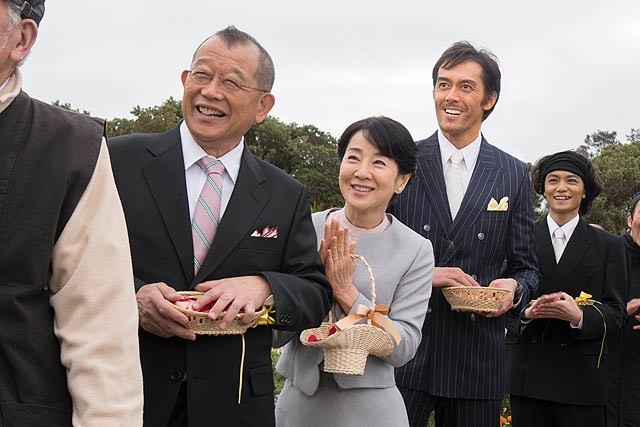
During my flight home from Hawaii I watched the film ふしぎな岬の物語 (Fushigi na misaki no monogatari) or Cape Nostalgia, which I have wanted to see since it came out at the end of last year in Japan and got rave reviews. It is based on a book by Akio Morisawa, and tells the story of a café situated along a small cape in Chiba that is run by an elderly woman named Etsuko Read More

